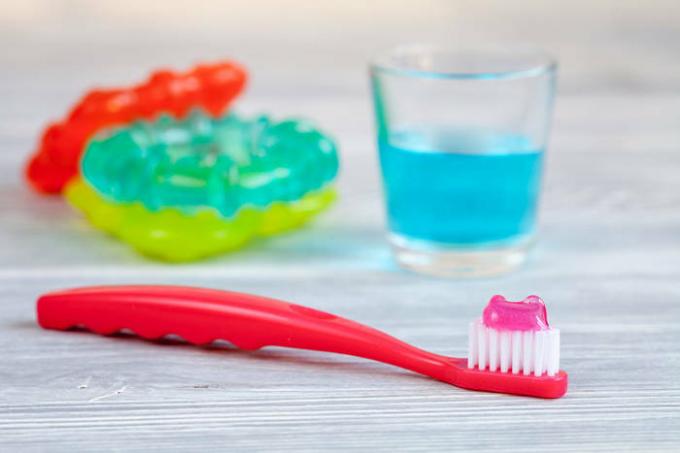Choosing a toothbrush and toothpaste for a child should be done according to the rules. Dentists advise to rely on the size of the teeth and look for calcium glycerophosphate in the paste
Doctors have been saying for a long time: you need to start caring for children's teeth from the moment the first milk clove appears. And here, parents immediately face many questions related to oral hygiene products. How to choose a baby's first toothbrush? Is it the right brush for age? When can a child buy an electric toothbrush? Is fluoride in baby's toothpaste acceptable? Our experts provide answers to these questions: Natalia Sidorova, Head of Family Dentistry Sydorova Dental Clinic, and Mikhail Kafka, pediatric dentist of the medical center "Diamant Dent"
How to choose the right toothbrush for your child

Choose a toothbrush according to the size of children's teeth / istockphoto.com
“Direct dental care begins from the moment the first tooth erupts. That is, each child has its own time, - says Natalya Sidorova. - There are special silicone toothbrushes that a parent puts on a finger and cleans the surface of each tooth from all sides in a circular motion. If it is not possible to purchase such a "first" brush, the option with a bandage is quite suitable (we wind it on a finger and do everything the same as with a silicone brush). The most important task: to remove all soft plaque that remains on the teeth and creates a favorable environment for the growth of bacteria. "
When the baby already boasts more than five teeth, it's time to move on to use children's toothbrush. Again, everyone has this in their own time, so doctors do not talk about a specific age, so we focus on the presence of teeth. Now in stores there is a huge assortment of children's brushes with a gradation by age: from 6 months, from a year, from 18 months. But experts advise against looking at age criteria. “The brush is selected so that the size of the working part corresponds to the width of 1.5-2 children's teeth,” advises Mikhail Kafka. - It is important from an early age to interest the baby in cleaning, therefore, first of all, the brush should be liked. For example, it can be your favorite color or with a character from your favorite cartoon. "
Experts advise not to get carried away with the popular electric toothbrushes nowadays. “Electric brushes can be used from the age of 3, or rather, when a child has 20 teeth,” Sidorova emphasizes. - And it is better to alternate it with a regular toothbrush so that the child develops the skill of making circular (sweeping and scrubbing) movements in the oral cavity. Remember that before the age of 10, parents must definitely help their child to brush their teeth. However, there are times when a child does not allow adults to interfere with the cleaning process. Then an electric toothbrush comes to the rescue, because objectively it will clean your teeth better than a child can do it himself. "
How to choose the right toothpaste for your child

Toothpaste should not only be tasty, but also safe / istockphoto.com
Selection of toothpaste - for parents, too, a dilemma. After all, the choice should not be limited only to the taste of chocolate, strawberry or vanilla ice cream. “Pastes are selected by age and composition,” says Mikhail Kafka. - Here we read what is written on the packaging. Several elements are important for dental health. The first is calcium: in childhood, the tooth receives it from food and vitamins, and superficial application (with paste) will help to consolidate the result. That is, we are looking for calcium glycerophosphate in the paste. "
“Fluoride prevents the development of caries, but it can accumulate in the body,” the expert continues. - For example, the rate of fluoride in water is 0.7 mg / l. If the indicator is higher in the region of your residence, you do not need fluoride in the paste. In other cases, for children under 6 years of age, the fluoride concentration is 1000 ppm, and for adolescents and adults, 1350-1500 ppm. Also pay attention to the presence of xylitol in the paste: pastes with fluoride and xylitol are 13% more effective in resisting caries than pastes with fluoride alone. "
Doctors have not yet come to a consensus on fluoride. In some cases, according to the dentist's indications, fluoride pastes can be used with the eruption of the first tooth. But mostly they are not recommended for children under 3 years old, because babies often swallow toothpaste. “It is much better to use tin fluoride pastes instead of fluoride, but they are quite difficult to find in Ukraine,” Sidorova notes. “If there is no medical need, then for children from 3 years old and for adults, I recommend alternating the use of a paste without fluoride and with fluoride: in the morning one, in the evening - another”.
You will also be interested to read:
What to do if your toddler doesn't want to brush his teeth: 5 tips for parents
How to teach a child to brush their teeth in a playful way: a master class from the Tooth Fairy
5 rules of hygiene of milk teeth, which you need to teach your child

